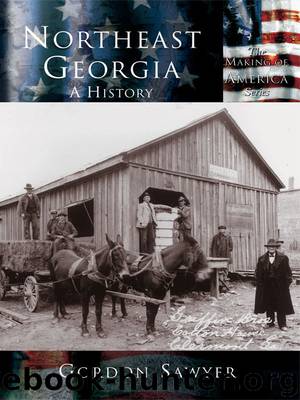Northeast Georgia by Gordon Sawyer

Author:Gordon Sawyer
Language: eng
Format: epub
Publisher: Arcadia Publishing
Published: 2011-09-18T16:00:00+00:00
A young man goes courting in his Walker buggy. The buggy had a black body, plush cushions, and red running gear. It cost about $70 in 1895, and the horse cost extra.
This 1912 sorghum mill was operated by steam power.
While agriculture brought in more total income prior to 1900 than everything else put together, what about townsfolk? How did they make a living? Like the farm folk, town dwellers were industrious people who usually had their own gardens. Some had their own cows for milk. Most had sewing machines and bought patterns to make their own clothes, and they expected to repair them. They found ways to make “extra” money. For instance, in the year 2000, property along Gainesville’s Green Street has many very large and productive pecan trees, most estimated to be more than 100 years old.
A house with six to eight rooms could be rented (if available) for $10 to $15 per month. Or, if a person chose to build (according to Gainesville’s 1888 promotional booklet), “A neat frame house, four rooms 15 x 15, with fire place in each, hall in center, veranda front and rear, plastered and painted, can be completed for $600.” The brochure went on to say, “A building and loan association is in successful operation, from which those wishing to build may obtain money for that purpose, to be repaid in installments.”
The same source reported that “Skilled labor brings from $1.25 to $2.50 per day; common labor from 50 cents to 75 cents per day.” This was before the days of either withholding taxes or two-income families. Jobs were scarce in Georgia’s mountainous area before 1900, but business was flourishing, the population was increasing, and the economy was looking up. Gainesville was pushing for more economic growth, and about 1890, the city printed and circulated a leaflet encouraging workers and businesses to move to this “Queen City of North Georgia.” The pamphlet pointed out that people were working in a diversity of businesses: “One Cotton Factory, Two Planing Mills, Door and Sash Factory, one Foundry, one extensive Carriage Factory, Two Tin Factories, One Harness and Saddlery Factory, Three Brick Yards, Four Large Livery Stables ...” Jobs were also available at “Six Large Hotels, kept in good style” and at “Four mineral Springs. Three of which have Commodious Hotels and Cottages ...” There was always some debate, both in the business community and among citizens generally, about the value of jobs in the seasonal “summer trade.”
The promotional brochure made a bold bid for investors to come to Gainesville and establish a furniture factory, a wagon factory, foundry and machine shops, and another cotton factory. The pamphlet ended as follows: “Our winters are short and Mild, our summers cool, scarcely a day in the year when men cannot work out doors. Considering our advantages of Climate, Health, Churches, Education, Society and Water Power, we know of no more inviting section for our friends of the cold North ...”
Download
This site does not store any files on its server. We only index and link to content provided by other sites. Please contact the content providers to delete copyright contents if any and email us, we'll remove relevant links or contents immediately.
Shoot Sexy by Ryan Armbrust(17659)
Portrait Mastery in Black & White: Learn the Signature Style of a Legendary Photographer by Tim Kelly(16955)
Adobe Camera Raw For Digital Photographers Only by Rob Sheppard(16907)
Photographically Speaking: A Deeper Look at Creating Stronger Images (Eva Spring's Library) by David duChemin(16623)
Bombshells: Glamour Girls of a Lifetime by Sullivan Steve(13978)
Art Nude Photography Explained: How to Photograph and Understand Great Art Nude Images by Simon Walden(12977)
Perfect Rhythm by Jae(5326)
Pillow Thoughts by Courtney Peppernell(4214)
The Book of Joy by Dalai Lama(3904)
Good by S. Walden(3489)
The Pixar Touch by David A. Price(3369)
A Dictionary of Sociology by Unknown(3031)
Fantastic Beasts: The Crimes of Grindelwald by J. K. Rowling(2996)
Humans of New York by Brandon Stanton(2835)
Stacked Decks by The Rotenberg Collection(2812)
Read This If You Want to Take Great Photographs by Carroll Henry(2664)
On Photography by Susan Sontag(2578)
Insomniac City by Bill Hayes(2500)
Photographic Guide to the Birds of Indonesia by Strange Morten;(2491)
